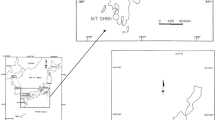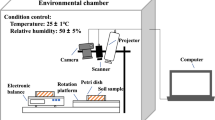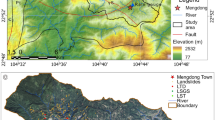Abstract
Soil in rainy and moist regions is influenced by heavy rainfall, which results in erosion from exposed slopes; local collapse and landslide may occur with the evolution of slope erosion. To determine the time–space effect of heavy rainfall on a slope, an in situ model test of a granite slope that was completely decomposed due to rainfall was conducted. The resistivity profile and surface shape parameters of the slope under continuous rainfall were monitored through electrical measurements and three-dimensional laser scanning. Infiltration and slope erosion evolution were analyzed based on the relationships between erosion rate and resistivity. With an increase in rainfall duration, a creep-type growth trend was observed for rill density on the slope surface with rill density change rates of approximately 0.6%/h, 0.1%/h, and 0.7%/h. A gradual decreasing trend of rill density was observed from the bottom to the top of the slope, and the decrease was approximately three times. When the rainfall duration was 12 h, a step-type growth trend for erosion rate was observed from 8.0–11.3 to 21.8–38.8%, i.e., an increase of approximately three times, indicating a transition from low-speed to high-speed growth in erosion. A gradual decreasing trend erosion rate was observed from the shallow to deep part of the slope; the average growth rates were 33.0%, 15.2%, and 4.9% when the rainfall duration was 16 h.























Similar content being viewed by others
Data availability
Some or all data, models, or code generated or used during the study are available from the corresponding author by request.
Abbreviations
- ΔU :
-
Potential difference
- I :
-
Current intensity
- ρ s :
-
Apparent resistivity
- K :
-
Electrode arrangement coefficient
- ρ :
-
Resistivity
- ω :
-
Moisture content
- α :
-
Horizontal scanning angle
- θ :
-
Vertical scanning angle
- S :
-
Distance measured by 3D laser scanning
- Δρ 0 :
-
Resistivity growth rate
- Δρ :
-
Resistivity change rate
- ∆W S :
-
Soil erosion change rate
- a, b, c :
-
Coefficient related to soil water content and other factors
- P :
-
Precipitation
- σ :
-
Conductivity
- x :
-
Total number of rills
- y :
-
Number of measurements per rill
- n :
-
Number of states
- n i :
-
Number of ion units
- Z :
-
Ion valence
- e :
-
Electronic charge
- T :
-
Absolute temperature
- D :
-
Diffusion coefficient
- ∆ρ ω :
-
Resistivity change rate due to moisture content
- ∆ρ W :
-
Resistivity change rate due to soil erosion
- t :
-
Rainfall duration
- L AB :
-
Electrode spacing
- ρ 0 :
-
Resistivity at t = 0
- μ:
-
Rill density.
References
Acharya G, Cochrane T, Davies T, Bowman E (2011) Quantifying and modeling post-failure sediment yields from laboratory-scale soil erosion and shallow landslide experiments with silty loess. Geomorphology 129(1–2):49–58
Ahmad N (2018) Detection of subsurface cracking depth using electrical resistivity tomography: a case study in Masjed-Soleiman, Iran. Constr Build Mater 192:1103–1108
Ayodele AL, Pamukcu S, Shrestha RA, Agbede OA (2017) Electrochemical soil stabilization and verification. Geotech Geol Eng 36:1283–1293
Biali G, Patriche CV, Pavel VL (2014) Application of GIS techniques for the quantification of land degradation caused by water erosion. Environ Eng Manag J 13(10):2665–2673
Biswas A, Roy P (2018) Meso-scale flanking structure and micro-scale push up structure within migmatitic biotite granite, Peninsular Gneissic Complex, Southern India. Int J Earth Sci 107(1):167–168
Cai GH, Du YJ, Liu SY, Singh DN (2015) Physical properties electrical resistivity and strength characteristics of carbonated silty soil admixed with reactive magnesia. Can Geotech J 52(11):1699–1713
Cano-Paoli K, Chiogna G, Bellin A (2019) Convenient use of electrical conductivity measurements to investigate hydrological processes in Alpine headwaters. Sci Total Environ 685:37–49
Carman PC (1939) Permeability of saturated sands, soils and clays. J Agric Sci 29(2):262–273
Chehlafi A, Kchikach A, Derradji A, Mequedade N (2019) Highway cutting slopes with high rainfall erosion in Morocco: evaluation of soil losses and erosion control using concrete arches. Eng Geol 260:105200
Chen H, Lee C, Law K (2004) Causative mechanisms of rainfall-induced fill slope failures. J Geotech Geoenviron Eng 130(6):593–602
Cividini A, Gioda G (2004) Finite-element approach to the erosion and transport of fine particles in granular soils. Int J Geomech 4(3):191–198
Cleveland RB, Cleveland WS, McRae JE, Terpenning I (1990) STL: a seasonal-trend decomposition. J off Stat 6(1):3–73
Comino JR, Senciales JM, Ramos MC, Martínez-Casasnovas JA, Lasanta T, Brevik EC, Ries JB, Ruiz Sinoga JD (2017) Understanding soil erosion processes in Mediterranean sloping vineyards (montes de málaga, spain). Geoderma 296:47–59
Crosta G, Prisco CD (1999) On slope instability induced by seepage erosion. Can Geotech J 36(6):1056–1073
Cui Y, Jiang Y, Guo C (2019) Investigation of the initiation of shallow failure in widely graded loose soil slopes considering interstitial flow and surface runoff. Landslides 16(4):815–828
Fang LL, Qi JL, Ma W (2012) Freeze-thaw induced changes in soil structure and its relationship with variations in strength. J Glaciol Geocryol 2:435–440
Forster GR, Meyer LD (1972) Transport of soil particles by shallow flow. Trans Am Soc Agric Eng 15(1):99–102
Gilley JE, Kottwitz ER, Simanton JR (1990) Hydraulic characteristics of rills. Trans ASAE 33(6):1900–1906
Gottlieb MH, Sollner K (1968) Failure of the Nernst-Einstein equation to correlate electrical resistances and rates of ionic self-exchange across certain fixed charge membranes. Biophys J 8(5):515–535
Grigor’ev VY, Kuznetsov MS, Abdulkhanova DR, Bazarov OA (2008) Calculation of parameters of soil particles detached and transported by shallow flows upon rill erosion. Eurasian Soil Sci 41(3):302–311
Hama NA, Ouahbi T, Taibi S, Souli H, Fleureau JM, Pantet A (2017) Relationships between the internal erosion parameters and the mechanical properties of granular materials. Eur J Environ Civ Eng 23(11):1368–1380
Hicher PY (2013) Modelling the impact of particle removal on granular material behaviour. Géotechnique 63(2):118–128
Iverson RM, Major JJ (1986) Groundwater seepage vectors and the potential for hillslope failure and debris flow mobilization. Water Resour Res 22(11):1543–1548
Jiang YM, Shi HJ, Wen ZM, Guo MH, Zhao J, Cao XP, Fan YM, Zheng C (2020) The dynamic process of slope rill erosion analyzed with a digital close range photogrammetry observation system under laboratory conditions. Geomorphology 350:106893
Karim MZ, Tucker-Kulesza SE (2018) Predicting soil erodibility using electrical resistivity tomography. J Geotech Geoenviron Eng 144(4):1–11
Kibria G (2014) Evaluation of physico-mechanical properties of clayey soils using electrical resistivity imaging technique. The University of Texas at Arlington, USA (PhD thesis)
Kim YK, Lee RR (2010) Field infiltration characteristics of natural rainfall in compacted roadside slopes. J Geotech Geoenviron Eng 136(1):248–252
Koc B, Ma Y, Lee Y (2000) Smoothing STL files by Max-Fit biarc curves for rapid prototyping. Rapid Prototyp J 6(3):186–205
Kuhn NJ, Bryan RB (2004) Drying, soil surface condition and interrill erosion on two ontario soils. CATENA 57(2):113–133
Léonard J, Richard G (2004) Estimation of runoff critical shear stress for soil erosion from soil shear strength. CATENA 57(3):233–249
Liu WP, Ouyang GQ, Luo XY, Luo J, Hu LN, Fu MF (2020) Moisture content, pore-water pressure and wetting front in granite residual soil during collapsing erosion with varying slope angle. Geomorphology 362:107210
Liu Z, Zhu SJ, Shi HG, Wang YH, Tong N, Chen JX (2014) Discussion on integrated management technology of mapping data for Highway One in Congo (Brazzaville). Sci Surv Mapp 39(11):126–128
Masrur M, Bora M, Kristen SC (2019) Freeze-thaw performance of phase change material (PCM) incorporated pavement subgrade soil. Constr Build Mater 202:449–464
Mualem Y (1976) A new model for predicting the hydraulic conductivity of unsaturated porous media. Water Resour Res 12(3):513–522
Pizer SM, Amburn EP, Austin JD (1987) Adaptive histogram equalization and its variations. Comput vis Graph Image Process 39(3):355–368
Quan X, He J, Cai Q, Sun L, Wang S (2020) Soil erosion and deposition characteristics of slope surfaces for two loess soils using indoor simulated rainfall experiment. Soil till Res 204:104714
Rahardjo H, Ong TH, Rezaur RB, Leong EC, Fredlund DG (2010) Response parameters for characterization of infiltration. Environ Earth Sci 60(7):1369–1380
Song W, Liu PL, Yang MY (2004) Study on erosion process by the REE tracer method. Adv Water Sci 15(2):197–201
Wang YC, Lai CC (2018) Evaluating the erosion process from a single-stripe laser-scanned topography: a laboratory case study. Water 10(7):956
Wen X, Deng X (2020) Current soil erosion assessment in the Loess Plateau of China: a mini-review. J Clean Prod 276(3):123091
Wu Q, Wang CM, Song PR, Zhu HB, Ma DH (2014) Rainfall scouring test and 3D particle flow fluid solid coupling simulation of loess steep slope. Rock Soil Mech 4:977–985
Wu SB, Chen L, Wang NL, Li J, Li JK (2020) Two-dimensional rainfall-runoff and soil erosion model on an irregularly rilled hillslope. J Hydrol 580:124346
Yu Y, Wei W, Chen LD, Feng TJ, Daryanto S (2019) Quantifying the effects of precipitation, vegetation, and land preparation techniques on runoff and soil erosion in a Loess watershed of China. Sci Total Environ 652:755–764
Zhang L, Wu F, Zhang H, Zhang L, Zhang J (2019) Influences of internal erosion on infiltration and slope stability. Bull Eng Geol Env 78(3):1815–1827
Zhang LL, Zhang J, Zhang LM, Tang WH (2011) Stability analysis of rainfall-induced slope failure: a review. Proc Inst Civ Eng Geotech Eng 164(5):299–316
Zheng FL (1989) A research on method of measuring rill erosion amount. Bull Soil Water Conserv 4:41–45
Funding
This study was supported by the National Key R&D Program of China (2018YFC1504504).
Author information
Authors and Affiliations
Corresponding author
Rights and permissions
About this article
Cite this article
Yuan, G., Che, A. Evolution and spatio-temporal characteristics of slope erosion due to rainfall in Southwest China. Bull Eng Geol Environ 81, 270 (2022). https://doi.org/10.1007/s10064-022-02767-z
Received:
Accepted:
Published:
DOI: https://doi.org/10.1007/s10064-022-02767-z




